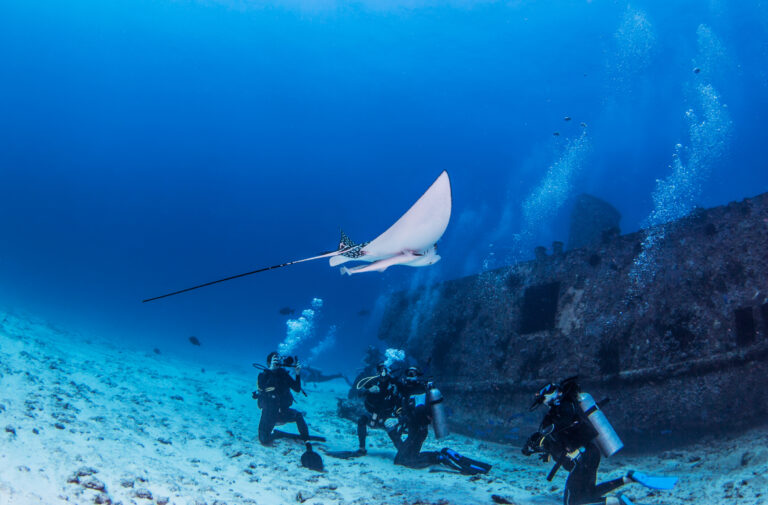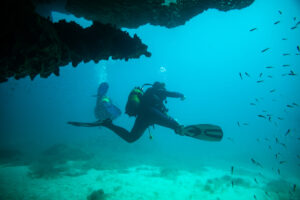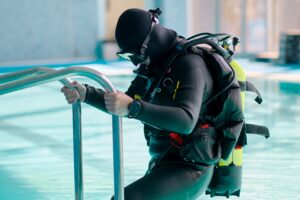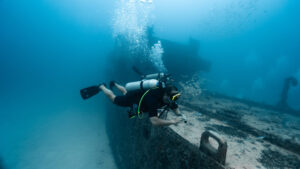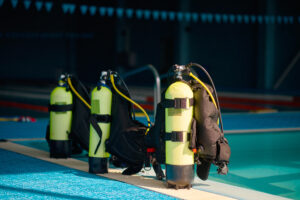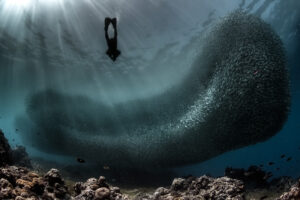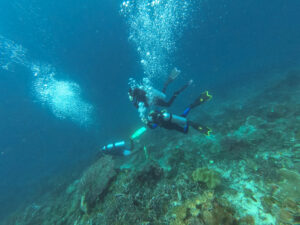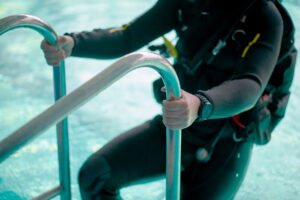What is “Out of Air”?
In the context of scuba diving, “out of air” refers to a situation where a diver has depleted their air supply, presenting a critical emergency. This term underscores the paramount importance of air management for diver safety. Proper planning, vigilance, and awareness are essential to prevent such incidents, as running out of air underwater can lead to severe consequences, including drowning. Understanding the factors that contribute to air depletion and the measures to prevent and handle such emergencies is crucial for every diver.
Definition and Background
“Out of air” is a term used to describe a scenario where a diver exhausts their available air supply during a dive. This situation is extremely dangerous, as it leaves the diver without the means to breathe underwater. Historically, incidents of running out of air have been a primary cause of diving accidents and fatalities. Such occurrences highlight the necessity of meticulous air management and adherence to safety protocols.
Diving, as an activity, relies heavily on the careful monitoring and regulation of air supply. Divers use compressed air tanks, which provide the necessary oxygen to sustain breathing underwater. The duration for which a tank lasts depends on various factors, including the depth of the dive, the diver’s breathing rate, and the tank’s capacity. An average tank lasts between 45 minutes to an hour, but this can vary significantly based on individual conditions.
Air consumption rates can vary widely among divers. Factors such as physical exertion, anxiety, water temperature, and the diver’s fitness level all play a role. For instance, a diver who is swimming vigorously or is in a cold-water environment may consume air much faster than one who is calm and relaxed in warm waters. Understanding these variables and planning accordingly is vital to avoid an out-of-air emergency.
Causes of Air Depletion
Several factors can lead to a diver running out of air. One of the primary causes is overexertion. When a diver exerts themselves excessively, their breathing rate increases, leading to faster air consumption. This overexertion can result from swimming against strong currents, performing strenuous underwater activities, or simply from the stress and anxiety of being in an unfamiliar environment.
Equipment malfunctions are another common cause of air depletion. Issues such as regulator failure, which prevents the diver from accessing the air in their tank, or leaks in the air supply system, can rapidly reduce the available air. Regular maintenance and thorough pre-dive checks of all equipment are essential to minimize the risk of such malfunctions.
Poor air management and planning are also significant contributors to running out of air. Divers must plan their dives meticulously, considering factors such as depth, duration, and available air supply. Failing to monitor air levels regularly during a dive can result in an unexpected and dangerous depletion. Divers are trained to check their air gauges frequently and to maintain an awareness of how much air they have left relative to their planned dive profile.
Environmental factors can also affect air consumption. Diving in cold water can increase the rate of air usage as the body works harder to maintain its core temperature. Similarly, diving at greater depths increases air consumption due to the higher pressure. Understanding and anticipating these environmental impacts is crucial for effective air management.
Preventive Measures
Effective prevention of out-of-air situations starts with proper dive planning and air management strategies. Divers should always plan their dives with a safety margin for their air supply. This includes setting a turn-around point based on air consumption rates and ensuring there is sufficient air for a safe ascent and any potential emergencies.
Monitoring air supply effectively is another critical preventive measure. Divers should check their air gauges regularly throughout the dive and communicate with their dive buddies about their air status. This practice not only helps in keeping track of air consumption but also fosters a collaborative approach to safety.
Pre-dive equipment checks and regular maintenance are essential to prevent air depletion due to equipment malfunctions. Divers should inspect their tanks, regulators, and other gear before every dive to ensure everything is functioning correctly. Regular servicing of equipment by certified technicians can also help in identifying and fixing potential issues before they become critical.
Training and certification on air management are vital for every diver. Basic scuba certification courses cover the fundamentals of air management, but advanced courses provide more in-depth knowledge and skills. These courses teach divers how to handle different air-related emergencies, how to use redundant air sources, and how to execute safe ascents even in challenging situations.
Emergency Procedures
When a diver realizes their air supply is critically low or depleted, quick and decisive action is required. The first step is to signal to their dive buddy or the dive leader about the out-of-air situation. Divers are trained to use specific hand signals to communicate underwater, and the out-of-air signal is universally recognized.
Buddy breathing is a fundamental emergency procedure where two divers share a single air source. This method involves taking turns breathing from the same regulator, allowing both divers to conserve air and ascend safely. It is a critical skill that is taught in all basic scuba courses and practiced regularly to ensure proficiency.
Using an alternate air source, such as an octopus regulator, is another emergency procedure. Most divers carry an extra regulator specifically for emergencies. When a diver runs out of air, they can use their buddy’s octopus to breathe while making a controlled ascent to the surface. This practice enhances safety by providing a reliable backup in case of an air depletion scenario.
Ascent procedures in an out-of-air emergency must be executed carefully to avoid additional risks such as decompression sickness. Divers are trained to ascend slowly, even in emergencies, to allow their bodies to adjust to the decreasing pressure. If a diver is forced to make an emergency ascent without a buddy, they are taught to exhale continuously to avoid lung over-expansion injuries.
The psychological aspects of handling an out-of-air situation are also critical. Panic can exacerbate the problem, leading to poor decision-making and increased air consumption. Training emphasizes staying calm, thinking clearly, and executing the planned emergency procedures methodically. Regular practice of these skills helps divers remain composed and effective in real emergencies.
Technological Advances
Advancements in technology have significantly improved the ability to monitor and manage air supply during a dive. Modern dive computers are equipped with features that track air consumption in real-time, providing divers with continuous updates on their remaining air supply. These devices can also calculate safe ascent profiles and alert divers when they are approaching critical air levels.
Air-integrated dive computers have become increasingly popular. These devices connect directly to the diver’s air tank and provide detailed information about air pressure, consumption rates, and estimated remaining dive time. By integrating this data with depth and time information, these computers offer a comprehensive overview of the diver’s status, enhancing safety and situational awareness.
Innovations in regulator technology have also contributed to safer diving experiences. Newer regulators are designed to be more reliable and efficient, reducing the risk of malfunctions. Some advanced models include features like environmental sealing, which prevents water from entering the regulator mechanism, and balanced first and second stages, which ensure consistent air delivery regardless of depth or tank pressure.
Future trends in scuba technology are focused on further improving air management and safety. Research is ongoing into developing more efficient air delivery systems, enhanced monitoring devices, and integrated communication tools that allow divers to share real-time data with their dive buddies and surface support teams. These advancements aim to reduce the risk of out-of-air situations and improve overall diving safety.
Key Takeaways
Understanding the term “out of air” in scuba diving is crucial for ensuring safety underwater. Proper air management, effective communication with dive buddies, and thorough training on emergency procedures are essential to prevent and handle out-of-air situations. By staying vigilant and prepared, divers can mitigate risks and enjoy a safer diving experience.

